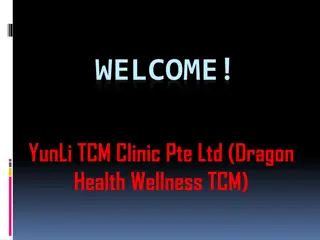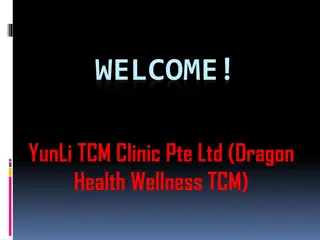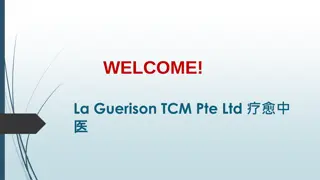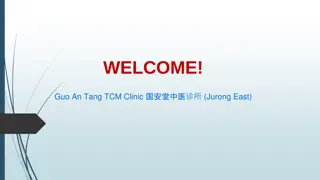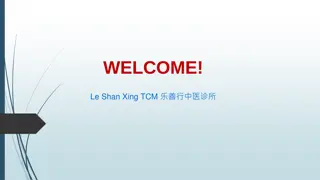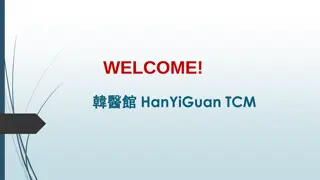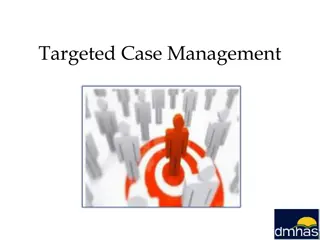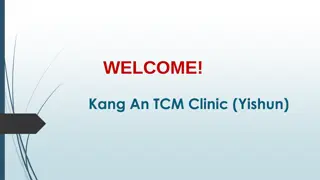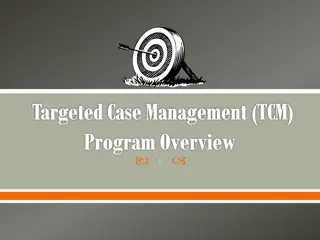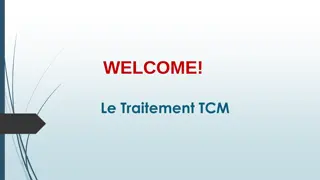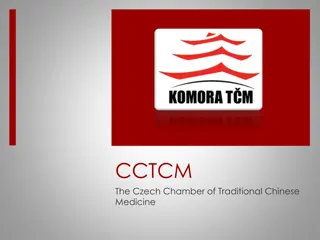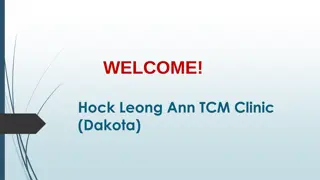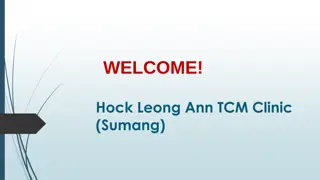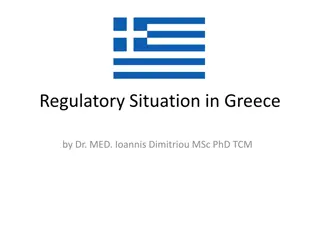Understanding Targeted Case Management (TCM) in Connecticut
Targeted Case Management (TCM) in Connecticut is a set of services aimed at assisting individuals with serious chronic mental illness, including substance use disorders. TCM providers play a crucial role in helping clients access medical, clinical, social, and educational services to enhance their quality of life. The TCM program is reimbursable through Medicaid, as defined in the Medicaid State Plan Amendment (SPA) approved by the Centers for Medicare and Medicaid (CMS).
Download Presentation

Please find below an Image/Link to download the presentation.
The content on the website is provided AS IS for your information and personal use only. It may not be sold, licensed, or shared on other websites without obtaining consent from the author. Download presentation by click this link. If you encounter any issues during the download, it is possible that the publisher has removed the file from their server.
E N D
Presentation Transcript
What We Will Cover in This Training Definition of TCM The Targeted Population TCM providers TCM levels of Care TCM Service Codes CLAMP TCM Documentation Record Retention Fiscal Overview RMTS
What is Targeted Case Management? Targeted Case Management (TCM) is a set of services provided to a Target Population that helps our clients gain access to needed medical, clinical, social and educational services to improve the quality of their lives. TCM services are reimbursable through Medicaid.
What is Targeted Case Management? TCM in Connecticut is defined within the Medicaid State Plan Amendment (SPA) which has been approved by the Centers for Medicare and Medicaid (CMS). In Ct. The Department of Social Services is the agency responsible for oversight of Medicaid and the SPA.
What is Targeted Case Management? The Medicaid State Plan Amendment (SPA) defines TCM services as: services furnished to assist individuals eligible under the State Plan in gaining access to needed medical, social, educational, and other services. The Medicaid Provider Manual defines case management services as the continuum of assessment, planning, linkage, support and advocacy activities systematically carried out by an individual case manager that are available to assist and enable an individual to gain access to needed medical, clinical, social, educational or other services.
Who is the Target Population for TCM? DSS defines the TCM target population based on ICD10 diagnosis codes. In Connecticut, the TCM target population is defined as individuals with serious chronic mental illness inclusive of individuals with substance use disorders and co-occurring mental illness.
Who is the Target Population for TCM? DSS maintains an updated approved codes list in Table 17 at https://www.ctdssmap.com/CTPortal/P ortals/o/StaticContent/Publications/Fee Schedule Instructions.pdf
TCM Providers Qualified Providers must have training, experience and expertise working with their target population. Details on the requirements that staff members must have to provide TCM services are outlined in the Medicaid State Plan Amendment (SPA). On a quarterly basis, TCM providers enroll staff in the Random Moment Time Study (RMTS).
TCM Levels of Care DMHAS has identified the following levels of care (LOC) for which TCM is expected: Assertive Community Treatment Community Support Programs MH Case Management MH Intensive Residential MH Residential Support MH Supervised Apartments MH Supportive Housing MH Transitional Residential
TCM Service Codes DDAP TCM Codes: TCM01 face to face with client TCM02 on the phone with client TCM03 with collateral TCM04- Audio and Visual with the client (Effective November 1, 2020) All TCM services can occur in the context of these 4 codes
What are TCM Services? C L A M P Coordination Linking Accessing, Assessing and Advocacy Monitoring Planning When this set of services is included in the Treatment Plan, they should be documented and coded as TCM.
COORDINATING Coordinating Services, Resources &Plans Coordination of care that involves a person interacting with external resources. Coordinating referral or supports Coordinating schedules and appointments with outside agencies for or with the client. Coordinating a plan of services, reviewing services and activities to ensure that the plan continues to meet the wants and needs of the client.
COORDINATING Example: A client s mother calls, asking what resources are available in the community to help educate her family on her son s illness. You refer the mother to the National Alliance on Mental Illness (NAMI).
LINKING Linking to Services & Resources Linking a client to outside resources. Linking the client with providers and other agencies to obtain services which addresses the client s needs and helps them achieve the goals documented in their recovery plan.
LINKING Example: Your client comes to your office and complains that he is isolated and lonely. You link him to Toivo, which is run by an external mental health agency, Advocacy Unlimited.
ACCESSING Linking and Referring to Needed Services Services that assist and enable the client to gain access and maintain needed medical, clinical, social, educational or other services.
ACCESSING Example: Your client calls you and says his roommates are harassing him and threatening to kick him out of his apartment. You help the client access legal assistance through Connecticut Legal Rights Project (CLRP) to discuss his housing rights.
ASSESSING Comprehensive assessments at admission. Reassessments performed at least annually. Assessments and reassessments completed for the purposes of developing a treatment plan or a treatment plan update.
ASSESSING EXAMPLE: A new client is enrolled at your agency. You administer a complete biopsychosocial to assess the needs to be addressed on the treatment plan.
ADVOCACY Helping a client obtain something they desire; eliminating a barrier.
ADVOCACY Example: Your client loses their job at the grocery store due to tardiness. Since then you and the client have been working on strategies to help him wake up on time. You then reach out to the grocery store manager to advocate for the client to get his job back and assure the store manager that he has learned new skills to minimize the issue such as using multiple alarm clocks and working on better sleep habits.
MONITORING Monitoring progress of a treatment plan objective, clearly identified in the intervention as a monitoring activity, not routine follow-up. Activities are necessary to ensure the plan is implemented and adequately addresses the client s needs. Services in the recovery plan are adequate.
MONITORING Changes in the needs or status of the individual are reflected in the service plan. Adjustments in the plan and service arrangements with providers are made as necessary and as situations change with the client.
MONITORING Monitoring can be provided: Face to face or by telephone In a case conference with the client present Through collateral contact with family, friends, providers and others Conducted as frequently as prescribed in the recovery plan.
Monitoring Example: The nurse, as part of the treatment plan, is going to monitor the side effects of the client s new medication on a monthly basis. The nurse will monitor through bloodwork and client self report. Each monthly monitoring activity is 1 TCM for as long as this activity is an intervention on the treatment plan.
CONFUSION ABOUT MONITORING What it is & What it is not Monitoring involves active observation of the service plan to make sure it is being properly implemented and meets the needs of the client. Monitoring also involves consistent help in identifying problems, modifying plans, ensuring resources are available to achieve goals and/or the objective has been achieved, and monitoring the client s participation in the plan. Monitoring assures services are delivered as documented in the service plan, services in the plan are adequate for the client and that necessary adjustments are made in the service plan when changes are needed.
CONFUSION ABOUT MONITORING What it is & What it is not Confusion about the self administration of medication. Medication delivery is not a TCM activity. Nor is supervising/observing clients take their medication. The client needs to have full access to their medications and make a choice to take or not take them. The monitoring occurs when in the service plan it is written that the staff will monitor that client has taken their medication in a specific time frame (example; weekly) and that the staff person monitors via looking in the pill box or counting pills in a pill bottle.
PLANNING Planning with a client on any specific aspect of their goals and needs, or by participating in a treatment planning conference with a client, the client s other providers and any natural supports.
PLANNING Example: Your client meets with you to discuss the possible side effects of alcohol on his depression. You discuss possible interventions to include on the plan to reduce his alcohol intake over the next 6 months.
TCM DOCUMENTATION In order to use a TCM code there must be the following items; 1. Initial and Ongoing Assessments- these determine the need for any medical, social, educational and other services. Assessment activities include taking a client history, identifying needs, completing related documentation and gathering information from other sources. Reassessments occur at least annually but may be done more frequently. Includes a diagnosis. Have the client sign a release of information (ROI) for record reporting and DDaP.
TCM DOCUMENTATION 2. An Active Recovery Plan that identifies the plan for services. Identifies areas of need Has TCM goals and objectives Has TCM interventions with anticipated duration, frequency, target dates and person(s) responsible. Client signature or evidence of client participation-Use quotes- Document why the client refuses to sign or refuses to participate if that is the case.
TCM DOCUMENTATION 3. The Progress Note documents the services being delivered. The activity provided must reference a Goal in the recovery plan. The Intervention (What you did) and the client s Response to the intervention must be documented. The Plan for the next encounter must be documented.
Lets go back to the examples A client s mother calls, asking what resources are available in the community to help educate her family on her son s illness. You refer the mother to the National Alliance on Mental Illness (NAMI).
TCM DOCUMENTATION Writing the Note Goal- I want to feel better and get rid of the stress in my life Mrs. Jones called this clinician(job title)upset that her husband and family are having difficulty with their son s behavior and inconsistent use of his psychotropic medications. Mrs. Jones expressed that her husband and Jim(name of client) have been fighting a lot and everyone is feeling stressed and anxious. This clinician informed and suggested coordinating(TCM service) a referral to NAMI.(Intervention) Mrs. Jones was pleased to hear of a community resource that focuses on supporting the family of someone with mental illness. She commented that her husband might not be willing to go with her.(Response) I asked Mrs. Jones to call me after she attends her first meeting to discuss if she feels this a good option for her or to explore other possible resources.(Plan) C.M. Zambetti, LPC, LADC(name of person providing the service and job title/credentials)2/25/20(Date)Start 11:16-End11:42 (Units) Total 26 minutes (Duration) collateral in staff office (Location)
Lets go back to the example Your client comes to your office and complains that he is isolated and lonely. You link him to Toivo, which is run by an external mental health agency, Advocacy Unlimited.
TCM DOCUMENTATION Writing the Note Goal- I want friends to hang out with and a girlfriend. Brian(Name of Client) came to this Case Manager s (Job title) office. He appeared somewhat anxious and expressed that he has been feeling lonely and hasn t seen his friends in a long time. This C.M. suggested linking(TCM service) him Toivo and informed that there are lots of opportunities to meet people, participate in groups, and make friends. (Intervention) Brian stated he was willing to give it a chance and said he might be interested in a meditation group also.(Response) Will meet Brian Thursday to explore and set up transportation for him to get to the location which is out of town.(Plan for the next session) C. M. Zambetti, LPC, LADC (name of person providing the service and job title/credentials) 2/25/20 (Date) Start 2:08- End 2:44 (Units) Total 36 minutes(Duration) Face to Face in staff office.
Lets go back to the examples A client calls her Case Manager and says her roommates are harassing her and are threatening to kick her out of the apartment. The Case Manager helps the client access legal services through Connecticut Legal Rights Project (CLRP) to discuss her housing rights.
TCM DOCUMENTATION Writing the Note Goal- I want to stay in my apartment so I can get my kids back Cathy (name of client) called upset that she hasn t been getting along with her roommates and they have been fighting about chores. They threatened that if she doesn t keep the kitchen clean they are going to kick her out of the apartment. This Case Manager(job title)calmed her down and reassured her that she has rights as a tenant . This worker informed Cathy about CLRP and how they help people with housing issues like hers.(Intervention) Cathy seemed relieved when she heard that she had the right to stay in her home.(Response) Cathy will come in at 3pm today and help her access(TCM Service) CLRP regarding his housing issue.(Plan for next session) C. M. Zambetti, LPC, LADC (Name of person providing the service and job title/credentials) 2/25/20 (Date) Start 10:02- End 10:21 (Units) Total 19 minutes (Duration) Phone in staff office (Location)
Lets go back to the examples A new client is admitted into your program. The Clinician administers a complete biopsychosocial to assess the needs to be addressed on the Treatment Plan.
TCM DOCUMENTATION Writing the Note Goal I want to be healthier so I feel better and can get a job This clinician(Job title) administered a comprehensive assessment to assess(TCM Service) Linda s (Client name) skills and areas of need to develop her treatment plan.(Intervention) Linda was cooperative, engaged and willing to answer the questions. She appeared interested in lowering her blood pressure and eating better since she was told recently by her PCP that she is obese and needs to lose weight.(Response) Meet next Wednesday to develop her treatment plan.(Plan for nest session) C. M. Zambetti, LPC,LADC (Name of person providing the service and job title/credentials) 2/25/20 (Date) Start 11:00- 12:02(Units) Total 62 minutes (Duration) Face to Face staff office (Location)
Lets go back to the examples The client losses their job at the local grocery store due to tardiness, the client and the Employment Specialist have since been working on strategies to help the client wakeup on time. The Employment Specialist reaches out to the grocery store hiring manager to advocate for the client to get his job back, and ensures the client has learned new skills to minimize this issue such as using multiple alarm clocks, and working on better sleep habits.
TCM DOCUMENTATION Writing the Note Goal- I want to get a job so I have money to do fun things This Employment Specialist(job title) called Eric s(name of client) former boss at Big Y where he used to work. This ES stated that Eric expressed that he really liked his job and would like to come back. When the Manager listed the issues he had with Eric that led to his termination this ES advocated(TCM service) for Eric to be given another opportunity. This ES explained that Eric has been working on going to bed and getting up on a regular schedule and using an alarm clock, and that Eric says he feels much less tired since he has made these changes to his sleep routine. (Intervention) The manager seemed pleased that Eric heard his concerns and commented that Eric was a good worker when he showed up.(Response) Eric and this ES to meet with the Manager next Monday to discuss the possibility of being rehired. (Plan for the next session) C. M. Zambetti, LPC, LADC (name of person providing the service and job title/credentials) 2/25/20 (Date) Start 2:45-End 3:05 (Units) Total 20 minutes (Duration) Collateral in staff office.(Location)
Lets go back to the examples The nurse, as a part of treatment plan, is going to monitor the side effects of the client s new medications on a monthly basis. The nurse will monitor through blood work and client self report. Each monthly monitoring activity is 1 TCM for as long as this activity is an intervention on the treatment plan.
TCM DOCUMENTATION Writing the Note Goal- get off these meds that make me feel tired and depressed so I can be a good mother to my 2 boys This Nurse (Job Title) met with Belinda(name of client) to monitor (TCM service) her response after one month on her new medication clozapine. Reviewed with Belinda that her bloodwork came back normal and asked her how she was feeling since starting.(Intervention) Belinda expressed concern that she had gained some weight and felt bloated.(Response) This Nurse did confirm that there could be some weight gain and encouraged her to look at her diet and exercise more.(Intervention) Belinda was pleased her bloodwork was good and commented that she really did not like exercise.(Response) Meet next month to review lab results and to look at some ways to add some exercise to her daily routine. (Plan for the next session) Susan Jones, LPN (name of person providing the service and job title/credentials) 2/25/20(Date) Start-3:30-End 3:55(Units) Total 25 minutes(Duration) face to face in office.
Lets go back to the examples A client meets with you to discuss the possible side effects of alcohol on his depression. You discuss possible interventions to include on the plan to reduce his alcohol intake over the next 6 months.
TCM DOCUMENTATION Writing the Note Goal- I want to stop taking medication because it makes me feel like crap This counselor(job title) met with Bob(Name of Client) following completion of his substance use assessment. This counselor explained that Bob s use puts him in the risky category for future abuse and as a depressant may be having a negative impact on his depression.(Intervention). Bob expressed that he does not want to stop drinking but was willing to look at a plan at reducing his intake(Response).Bob and I came up with a plan (TCM service) to reduce his weekly consumption while still being able to enjoy more than 1, but less than 4 alcoholic beverages on the weekends.(Intervention) Will meet with Bob two Mondays from today and review Bob s adherence to the plan and discuss any changes in his level of depression(Plan for the next session) C.M. Zambetti, LPC, LADC (name of person providing the service and job title/credentials) 1/04/20(Date) Start9:02- End9:52 (Units)Total 50 minutes(Duration) face to face in client s apartment(Location)
TCM DOCUMENTATION Writing the Note Progress Notes: 1. Tell a story- a good story has a beginning, middle and end. 2. Provide a narrative of the objectives and interventions that have been worked on. 3. Details the client s progress in taking small steps to achieve life goals that are important to them. 4. Provides a summary of the work and progress that has been made for the next Recovery Plan update.
TCM DOCUMENTATION Writing the Note Services to clients who have no assessment, no treatment plan, or an expired treatment plan cannot be billed. Services to clients in an inpatient setting, nursing home, or jail cannot be billed. Double billing is prohibited. Please ensure that the service location is input into DDaP.
TCM DOCUMENTATION Writing the Note TCM codes cannot be used for conducting collateral services within your organization. TCM codes cannot be used for medical, educational, social or skill building services.


